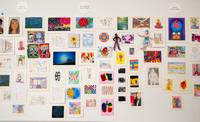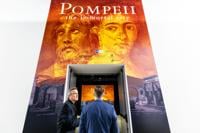
On Saturday, the Arlington Museum of Art reopened its doors to the public in the Esports Stadium and Expo Center on Ballpark Way, unveiling a new, innovative space featuring exhibits highlighting the connection between humanity, nature and their tangled history.
The exhibitions and gallery headlining the reopening, “Pompeii: The Immortal City,” “One Point Five Degrees” and the “Youth Art Month” project, combine traditional art and historical artifacts with modern art and technology.
With a space nearly eight times larger than the previous location, the AMA can expand its skills and collections, allowing more evocative exhibitions for the community.
Director of engagement Matt Randolph said the move was largely supported through a $500,000 grant from the Arlington Tomorrow Foundation, a philanthropic group funded by the city’s natural gas drilling resources, alongside the museum’s supportive donor base.
According to a media release, the city allocated around $4.8 million for various renovation projects to the stadium and expo center, which will be completed in two phases.
Phase I interior improvements, in which the city has invested $2.9 million, began in October and anticipates completion by the end of the year. This will transform the museum’s footprint with galleries, an education center and more.
Phase II interior improvements, which has $1.9 million invested in it, will be made to the shared corridors between the AMA and Esports arena, as well as the western face of the building.
In a brand new space with limitless possibilities, the museum’s staff is excited about the present and anticipating the future.
Randolph said while the AMA has been around for a long time, they now have the mindset of being world-class.
“We want the City of Arlington to be proud of us,” he said. “To know that they have an art museum that is bringing in art that is educational, that is expressive for the city itself, but also for them to understand that having an art museum is important for the city, especially economically.”
The debuting exhibitions, however, aren’t the first time the AMA has wowed crowds with innovative ideas and exhibits.

Last summer, the AMA made waves with its record-breaking collection of “Taylor Swift: The Eras Tour” exhibit, which included well-known clothing articles from her various projects.
Other records were previously set by the museum’s portrayal of “Keith Haring: Against All Odds,” “30 Americans,” “A Knight’s Tale” and Disney Art from Private Collections.
Kendall Quirk, registrar director of exhibitions, said the museum is always looking to bring something new to the community.
“We’ve always tried to bring exhibits that maybe our community either can’t go to see or haven’t seen in a while, or maybe something they’re interested in,” Quirk said.
The “Pompeii: The Immortal City” and “One Point Five Degrees” exhibits were chosen specifically to highlight the capabilities of the new space, president and CEO Chris Hightower said in the media release.
The two exhibits, while drastically different, share similarities in their purpose. Both make use of modern technology and multimedia art, elaborating on the relationship between humanity and the natural world.
“One Point Five Degrees” debuted in the museum’s immersive galleries and consists of two parts. Using projections to illuminate the walls, the first half is filled with images of the arctic landscape taken by Fort Worth-based artist Adam Fung.
The second half takes a turn into the realm of digital art, displaying blooming flora in a collection of pieces by Canadian artist Sabrina Ratté.
“Pompeii: The Immortal City” on the other hand tells an intricate story, combining multimedia art with traditional displays of artifacts.
The exhibit makes use of digitization to present a variety of information to the viewer. In one portion, attendees are asked to step into a circular room that displays a 360-degree video on the wall panels, transporting the audience into the center of Pompeii just before the eruption of the Mount Vesuvius volcano.
Randolph said using the technology this way amplified the artistic expression of the exhibit.
“You’re literally stepping into what it was like. So that was very important to us, because again, it’s all about the feeling,” he said. “You can get that emotional attraction to it, you can get that feeling of that fear or understanding.”
The exhibit also utilizes video, visualizing how some of the artifacts may have been used by the people of Pompeii.

Giovanni Di Pasquale, the Pompeii exhibit’s curator, discussed the medium on opening day during the AMA’s Articulate Art Talk lecture series. He detailed the artifact’s usages and the story of the city’s economic influence, as well as the curation process and importance of having every artifact tell a story.
“You start [by] selecting the objects to tell the story that you want to share, it’s like writing a book with images,” Pasquale said.
Arlington has seen various changes and growth over the years, now holding the tagline “The American Dream City.”
Quirk said while the connection between “Pompeii: The Immortal City” and “The American Dream City” was unintentional, the exhibit helps highlight the city’s goal of being a part of that idea.
“You know, we wanted to bring some sort of aspect of culture, because that’s part of the American Dream,” she said. “Bringing culture to your community in whatever aspect that means.”
From immersive exhibits to community art galleries, the AMA is making use of their new space to serve the city while also looking forward and planning for the future.
“We’re very excited,” Randolph said, “We’re so ecstatic to be able to open up, especially with this premiere, but also we’re super excited about what the future holds with the exhibits that we have coming up.”
@marierenea.journal















